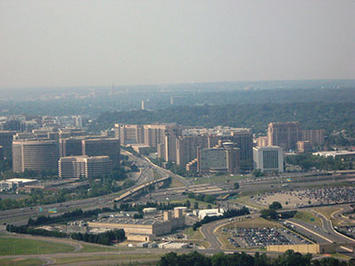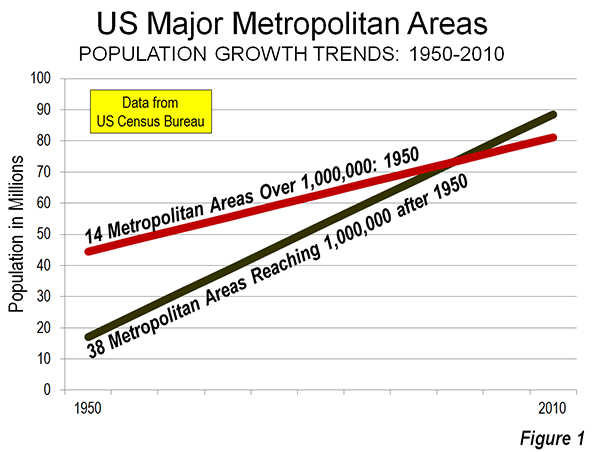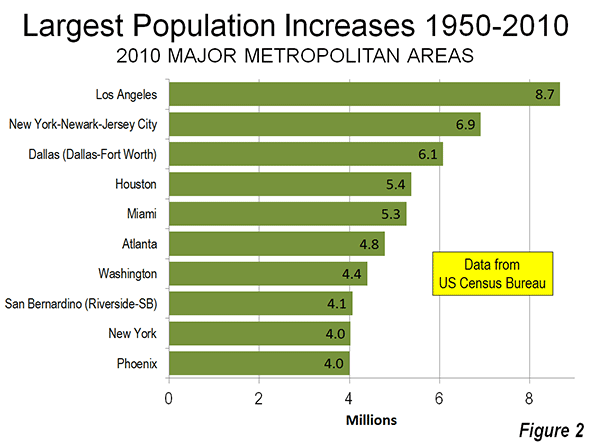
America has become much more metropolitan since 1950, when the Office of Management and Budget released the first modern criteria for determining the boundaries of metropolitan areas. Metropolitan areas are the economic or functional definition of the "city." They are otherwise known as labor markets and include the physical "urban area" (the area of continuous development) as well as economically connected rural territory from which people commute into the urban area. A previous article examined the development of the “physical” form of the city (urban areas) in the United States, from 1920 to 2010 (See Observations on Urbanization: 1920-2010).
Major Metropolitan Areas in 1950
In 1950, there were 14 major metropolitan areas in the United States (over 1,000,000 population). Their combined population was 44.5 million. By 2010, there were 52 major metropolitan areas, with a total population of 169.5 million. This increase, 124 million, is approximately equal to the population of France and the United Kingdom combined. While major metropolitan areas were increasing their population by 281 percent, the rest of the nation grew only 106 percent (Note 1).
Dispersion to Smaller Metropolitan Areas
As the nation was moving to major metropolitan areas, much of the growth was in the 38 smaller metropolitan areas that passed the 1,000,000 mark after 1950. These areas had 17.7 million residents in 1950. By 2010 they had added more than 70 million new residents, for a total population of 88.5 million. In contrast, the 14 metropolitan areas that had more than 1,000,000 population in 1950 grew only 36.5 million, to 81.1 million (Figure 1).

Among the metropolitan areas that had reached 1,000,000 population by 2010, the fastest growing were all in the Sun Belt. Las Vegas, which was too small to be a metropolitan area in 1950, grew 39 times (3,941 percent) compared to the 1950 population for the area constituting the 2010 metropolitan definition (Clark County). Orlando grew 17.6 times (1,757 percent), while Riverside-San Bernardino grew 14 times (1,400 percent). Three other metropolitan areas grew 10 times or more, including Phoenix at 11.6 times (1,164 percent), Charlotte at 10.3 times (1,025 percent) and Miami at 10.2 times (1,017 percent).
Los Angeles added the most to its population, at 8.7 million residents from 1950 to 2010. Perhaps surprisingly, however, New York also grew strongly, adding 6.9 million residents. Los Angeles, which grew quickly until recently, managed to reduce New York’s 8.5 million 1950 lead by only one-fifth by 2010. Dallas-Fort Worth added the third greatest number of new residents (6.1 million), partially by absorbing the former (and smaller) Fort Worth metropolitan area during the period. Houston added 5.4 million residents. Miami added 5.4 million residents, also incorporating smaller metropolitan areas, Fort Lauderdale and West Palm Beach. Chicago ranked surprisingly high, adding 4.0 million residents, the result of comparatively strong growth in the early decades (Figure 2). The strong population growth evident in New York and Chicago is largely attributable to much faster growth rates between 1950 and 1970 period.
The ascendancy of Texas is illustrated by the fact that its two largest metropolitan areas, Dallas-Fort Worth and Houston added more residents (Note 2) than the two largest metropolitan areas in California, Los Angeles, and San Francisco (11.5 million compared to 10.9 million). However, stronger long term California growth was indicated by the 4.1 million addition to the Riverside-San Bernardino metropolitan area (the “Inland Empire”), which is adjacent to the Los Angeles metropolitan area and has emerged as the dominant growth center of the state in recent decades.

Similar Regions, Big Differences
There were substantial contrasts in growth between similarly sized metropolitan areas in 1950 over the period.
Atlanta and nearby Birmingham were similar in population in 1950. Atlanta had a population of 672,000 (ranked 23) and Birmingham had 559,000 (ranked 27). By 2010, Atlanta had risen to a population of 5.3 million and a rank of 9th, compared to Birmingham’s 1.1 million and a rank of 49th.
A somewhat smaller, but significant difference is evident between Seattle and nearby Portland, which were nearly the same size in 1950 (733,000 and 705,000 respectively) ranking 20th and 21st respectively. Over the next 60 years, Seattle grew 2.8 million (some of it from absorbing the former Tacoma metropolitan area). By 2010, Seattle was the 15th largest metropolitan area in the nation, while Portland had fallen to 23rd, adding a smaller 1.5 million residents. Portland and San Francisco were the only major metropolitan areas in the West to fall in the national rankings between 1950 and 2010.
Slower Growth Major Metropolitan Areas
The slowest growing major metropolitan areas were Buffalo (4 percent), Pittsburgh (6 percent), Cleveland (41.7 percent), Detroit 42.4 percent and New York (52 percent (Table 1).
| Table 1 | ||||||
| Major Metropolitan Areas: 2010, Change from 1950 | ||||||
| Population | Rank | |||||
| Metropolitan Area | 1950 | 2010 | Change | 2012 | 1950 | 2010 |
| Atlanta, GA | 671,797 | 5,286,732 | 687% | 5,457,831 | 23 | 9 |
| Austin, TX | 160,980 | 1,716,286 | 966% | 1,834,303 | 107 | 35 |
| Baltimore, MD | 1,337,373 | 2,710,489 | 103% | 2,753,149 | 12 | 20 |
| Birmingham, AL | 558,928 | 1,128,050 | 102% | 1,136,650 | 27 | 49 |
| Boston, MA-NH | 2,389,986 | 4,552,402 | 90% | 4,640,802 | 6 | 10 |
| Buffalo, NY | 1,089,230 | 1,135,511 | 4% | 1,134,210 | 14 | 47 |
| Charlotte, NC-SC | 197,052 | 2,217,035 | 1025% | 2,296,569 | 91 | 24 |
| Chicago, IL-IN-WI | 5,495,364 | 9,461,105 | 72% | 9,522,434 | 2 | 3 |
| Cincinnati, OH-KY-IN | 904,402 | 2,114,580 | 134% | 2,128,603 | 15 | 28 |
| Cleveland, OH | 1,465,511 | 2,077,240 | 42% | 2,063,535 | 10 | 29 |
| Columbus, OH | 503,410 | 1,901,965 | 278% | 1,944,002 | 32 | 32 |
| Dallas-Fort Worth, TX | 614,799 | 6,426,210 | 945% | 6,700,991 | 24 | 4 |
| Denver, CO | 563,832 | 2,543,478 | 351% | 2,645,209 | 26 | 21 |
| Detroit, MI | 3,016,197 | 4,296,247 | 42% | 4,292,060 | 5 | 12 |
| Grand Rapids, MI | 288,292 | 988,938 | 243% | 1,005,648 | 60 | 52 |
| Hartford, CT | 358,081 | 1,212,384 | 239% | 1,214,400 | 47 | 44 |
| Houston, TX | 806,701 | 5,920,456 | 634% | 6,177,035 | 18 | 6 |
| Indianapolis. IN | 551,777 | 1,887,877 | 242% | 1,928,982 | 29 | 33 |
| Jacksonville, FL | 304,029 | 1,345,596 | 343% | 1,377,850 | 56 | 40 |
| Kansas City, MO-KS | 814,357 | 2,009,338 | 147% | 2,038,724 | 17 | 30 |
| Las Vegas, NV | 48,289 | 1,951,269 | 3941% | 2,000,759 | NA | 31 |
| Los Angeles, CA | 4,367,911 | 12,828,842 | 194% | 13,052,921 | 3 | 2 |
| Louisville, KY-IN | 576,900 | 1,235,708 | 114% | 1,251,351 | 25 | 43 |
| Memphis, TN-MS-AR | 482,393 | 1,324,829 | 175% | 1,341,690 | 36 | 41 |
| Miami, FL | 498,084 | 5,564,657 | 1017% | 5,762,717 | 34 | 8 |
| Milwaukee,WI | 871,047 | 1,555,908 | 79% | 1,566,981 | 16 | 39 |
| Minneapolis-St. Paul, MN-WI | 1,116,509 | 3,348,859 | 200% | 3,422,264 | 13 | 16 |
| Nashville, TN | 321,758 | 1,670,890 | 419% | 1,726,693 | 55 | 37 |
| New Orleans. LA | 685,405 | 1,189,863 | 74% | 1,227,096 | 22 | 46 |
| New York, NY-NJ-PA | 12,911,944 | 19,567,407 | 52% | 19,831,858 | 1 | 1 |
| Oklahoma City, OK | 325,352 | 1,252,992 | 285% | 1,296,565 | 53 | 42 |
| Orlando, FL | 114,950 | 2,134,411 | 1757% | 2,223,674 | 138 | 27 |
| Philadelphia, PA-NJ-DE-MD | 3,671,048 | 5,965,341 | 62% | 6,018,800 | 4 | 5 |
| Phoenix, AZ | 331,770 | 4,192,887 | 1164% | 4,329,534 | 51 | 14 |
| Pittsburgh, PA | 2,213,236 | 2,356,285 | 6% | 2,360,733 | 8 | 22 |
| Portland, OR-WA | 704,829 | 2,226,009 | 216% | 2,289,800 | 21 | 23 |
| Providence, RI-MA | 737,203 | 1,600,852 | 117% | 1,601,374 | 19 | 38 |
| Raleigh, NC | 136,450 | 1,130,490 | 729% | 1,188,564 | 125 | 48 |
| Richmond, VA | 328,050 | 1,208,101 | 268% | 1,231,980 | 52 | 45 |
| Riverside-San Bernardino, CA | 281,642 | 4,224,851 | 1400% | 4,350,096 | 63 | 13 |
| Rochester, NY | 487,632 | 1,079,671 | 121% | 1,082,284 | 35 | 51 |
| Sacramento, CA | 277,140 | 2,149,127 | 675% | 2,196,482 | 64 | 25 |
| Salt Lake City, UT | 274,895 | 1,087,873 | 296% | 1,123,712 | 68 | 50 |
| San Antonio, TX | 500,450 | 2,142,508 | 328% | 2,234,003 | 33 | 26 |
| San Diego, CA | 556,808 | 3,095,308 | 456% | 3,177,063 | 28 | 17 |
| San Francisco-Oakland, CA | 2,240,767 | 4,335,391 | 93% | 4,455,560 | 7 | 11 |
| San Jose, CA | 290,457 | 1,836,911 | 532% | 1,894,388 | 59 | 34 |
| Seattle, WA | 732,992 | 3,439,809 | 369% | 3,552,157 | 20 | 15 |
| St. Louis,, MO-IL | 1,681,281 | 2,787,695 | 66% | 2,795,794 | 9 | 18 |
| Tampa-St. Petersburg, FL | 409,143 | 2,783,243 | 580% | 2,842,878 | 41 | 19 |
| Virginia Beach-Norfolk, VA-NC | 446,200 | 1,676,820 | 276% | 1,699,925 | 38 | 36 |
| Washington, DC-VA-MD-WV | 1,464,089 | 5,636,232 | 285% | 5,860,342 | 11 | 7 |
| Notes on changes from 1950 | ||||||
| All first named municipalities were the central cites per OMB in 1950 except: | ||||||
| Norfolk was the central city of Virginia Beach | ||||||
| San Bernardino was the central city of Riverside-San Bernardino | ||||||
| Jersey City and Newark were also central cities of New York | ||||||
| Las Vegas 1950 is for Clark County (was not a metropolitan area) | ||||||
Meanwhile, 11 metropolitan areas fell from the top 50 in 1950. All were in the Northeast or Midwest, except for Knoxville, TN. Youngstown has been beset by economic difficulties throughout most of the period. In 1950, Youngstown was the nation’s 30th largest metropolitan area, larger than Atlanta, Phoenix and Las Vegas. However, Youngstown added only seven percent to its population over the 60 years, and fell to 93rd place. Wheeling-Steubenville (WV-OH) is one of the nation’s few genuine “shrinking cities,” that is a metropolitan area or an urban area that is losing population. Wheeling-Steubenville was ranked 48th in 1950. Since that time, the economic influence of Wheeling has deteriorated so much that OMB has split the metropolitan area into two parts, removing Weirton, WV (which includes Steubenville, OH). The Wheeling metropolitan area is approximately 60 percent smaller than in 1950 (Table 2).
| Table 2 | |||||
| Metropolitan Areas No Longer in Top 50 | |||||
| Population | Rank | ||||
| 1950 | 2010 | Change | 1950 | 2010 | |
| Youngstown, OH-PA | 528,498 | 565,773 | 7% | 30 | 93 |
| Albany, NY | 514,490 | 870,718 | 69% | 31 | 60 |
| Dayton, OH | 457,333 | 799,232 | 75% | 37 | 70 |
| Allentown, PA | 437,824 | 821,173 | 88% | 39 | 67 |
| Akron, OH | 410,022 | 703,205 | 72% | 40 | 74 |
| Springfield, MA | 407,255 | 621,570 | 53% | 42 | 83 |
| Toledo, OH | 395,551 | 610,001 | 54% | 43 | 86 |
| Wilkes-Barre, PA | 392,241 | 563,630 | 44% | 44 | 95 |
| Omaha, NE-IA | 368,395 | 868,116 | 136% | 45 | 61 |
| Wheeling, WV-OH | 354,092 | 147,950 | -58% | 48 | 273 |
| Syracuse, NY | 341,719 | 662,578 | 94% | 49 | 79 |
| Knoxville, TN | 337,105 | 837,571 | 148% | 50 | 64 |
Cities: From Monocentric to Polycentric to Edgeless
The changes that occurred in cities of the United States and elsewhere around the world have extended well beyond the population increases. The former monocentric model of the city, organized around a dense core has been recent placed by the polycentric city (with the new suburban employment centers documented by Joel Garreau as “edge cities”). In its revisions of the metropolitan area criteria for the 2000 census (Note 2), the Office of Management and Budget began defining core (as used in the encompassing metropolitan area term “Core Based Statistical Area”) as the urban area (urbanized area), rather than the former “central cities.” OMB has designated many suburban employment centers as "principal cities," and in consequence no longer has any suburban designation.
Robert Lang of the University of Nevada Las Vegas has shown that the evolution of metropolitan areas has been extending beyond the “edge cities” and has heralded the “edgeless city.” The dispersion continues.
Wendell Cox is a Visiting Professor, Conservatoire National des Arts et Metiers, Paris and the author of “War on the Dream: How Anti-Sprawl Policy Threatens the Quality of Life.
----------------
Note 1: Some of the metropolitan growth occurred as residents in counties that were not metropolitan in 1950 were added to metropolitan areas as their borders were defined outward. The current boundaries of the major metropolitan areas would have increased their 1950 population by 17 percent.
Note 2: The OMB final notice for 2010 defines “core” as “A densely settled concentration of population, comprising either an urbanized area (of 50,000 or more population) or an urban cluster (of 10,000 to 49,999 population) delineated by the Census Bureau, around which a Core Based Statistical Area is delineated. According to the OMB definition, the core is now an entire urban area, not a central city. The “building blocks” of urban areas are census blocks (smaller than census tracts), rather than municipalities, as had been the case before 2000.
Photo: Crystal City Employment Center: Virginia suburbs of Washington (by author)













Yes i am totally agreed with
Yes i am totally agreed with this article and i just want say that this article is very nice and very informative article.I will make sure to be reading your blog more. You made a good point but I can't help but wonder, what about the other side? !!!!!!THANKS!!!!!!
dare uno sguardo all'interno
Wow! What an eye opener this
Wow! What an eye opener this post has been for me. Very much appreciated, bookmarked, I can’t wait for more!
http://unlockherlegsdownload.com
I really enjoy simply
I really enjoy simply reading all of your weblogs. Simply wanted to inform you that you have people like me who appreciate your work. Definitely a great post. girlfriend activation system does it really work
wow, great, I was wondering how to cure acne naturally. and found your site by google, learned a lot, now i’m a bit clear. I’ve bookmark your site and also add rss. rebelmouse.com
Nice to read your article! I
Nice to read your article! I am looking forward to sharing your adventures and experiences.
the social man the girlfriend activation system download
Thanks for sharing nice
Thanks for sharing nice information with us. i like your post and all you share with us is uptodate and quite informative, i would like to bookmark the page so i can come here again to read you, as you have done a wonderful job.
click here for more
Hello, i am glad to read the
Hello, i am glad to read the whole content of this blog and am very excited and happy to say that the webmaster has done a very good job here to put all the information content and information at one place. desire system how to
I really enjoy simply reading all of your weblogs. Simply wanted to inform you that you have people like me who appreciate your work. Definitely a great post. www.haveyouseenhim.com
surprised how
Bitch is just a term used for girl who refuses dog's proposal.:P
Game Of Thrones Season 5 Episdoe 5
Game Of Thrones Season 5 Episdoe 5
Game Of Thrones Season 5 Episdoe 5
surprised so much
Wifi is like love. It's in the air.
Watch Pitch Perfect 2 Online Free
Avengers Age of Ultron Watch Online
Avengers Age of Ultron Watch Online
surprised
They say milk gives you strength so I drank 5 glasses and still couldn't move a wall, I tried 13 shots of vodka and saw the wall move itself ;-)
Mayweather Vs Pacquiao Live Stream
Mayweather Vs Pacquiao Live Stream
What a fantabulous post this
What a fantabulous post this has been. Never seen this kind of useful post. I am grateful to you and expect more number of posts like these. Thank you very much.
is the girlfriend activation system real